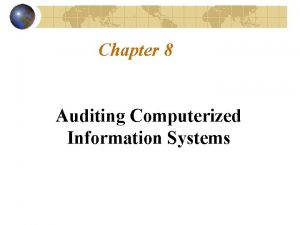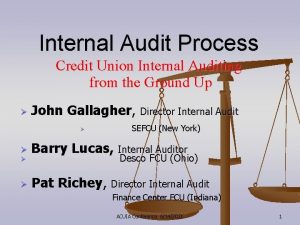THE NATURE OF INTERNAL AUDITING Dr Rilla Gantino















- Slides: 15

THE NATURE OF INTERNAL AUDITING Dr Rilla Gantino, SE. , AK. , MM PERTEMUAN I MAGISTER AKUNTANSI - FEB

VISI DAN MISI UNIVERSITAS ESA UNGGUL

Materi Sebelum UTS 01. The nature of internal auditing 02. 03. Standar Profesi Internal Audit & Kode Etik Pengendalian Internal 04. Perencanaan Internal Audit 05. Perencanaan Internal Audit 06. Field Work 07. Field Work

Materi Setelah UTS 08. UTS 09. Manajemen Resiko 10. Manajemen Resiko Audit Findings 11. 12. Audit Findings 13. Audit Report 14. Corporate Govenernance 15. Corporate Govenernance

KEMAMPUAN AKHIR YANG DIHARAPKAN • Memahami konsep dasar dari internal audit • Memiliki kemampuan untuk • Menjelaskan fungsi dan ruanglingkup pekerjaan auditing internal dan perbedaan auditing internal dengan external audit. • Menjelaskan bagaimana seharusnya hubungan antara auditing internal denan audit eksternal

Definition “Internal auditing is an independent, objective assurance and consulting activity designed to add value and improve an organization's operations. It helps an organisation accomplish its objectives by bringing a systematic, disciplined approach to evaluate and improve the effectiveness of risk management, control, and governance processes. ” The Institute of Internal Auditors

WHAT? • Internal auditing is an independent, objective assurance and consulting activity designed to add value and improve an organization's operations. It helps an organization accomplish its objectives by bringing a systematic, disciplined approach to evaluate and improve the effectiveness of risk management, control, and governance processes. • [The Institute of Internal Auditors, USA] • Remember, • The definition of I/A provides comprehensive guidelines for the framework of internal audit. It should always be kept in mind while I/A work is being carried out. It helps in devising the complete internal audit approach.

How are Internal Audit & External Audit different? Internal audit is focused at internal management support and improving systems, procedures and processes ⇉ External audit (EA): normally statutory requirement, unlike internal audit (IA) ⇉ EA reports are addressed to stakeholders: IA reports are addressed to Management ⇉ EA reports express an opinion on the financial statements prepared by the entity for a specified period: IA reports evaluate and check compliance against key internal controls ⇉ EA reports are usually public documents which are available to all stakeholders. IA reports are for use only by Management ⇉ EA reports do not make recommendations, although may have a Management Letter: IA reports are incomplete without ⇉ EA is basically a review of financial statements for compliance: IA seeks to ensure value for money to Management

WHY? • The main objectives of I/A are: ► to provide assurance on the adequacy, efficiency and effectiveness of the whole control environment, ► advise at an early stage in the implementation of any system developments, amendments to processes, making recommendations in the formation of policies, procedures and controls, and ► noting deviations from organizational policies, procedures and controls and recommending actions to mitigate the risks arising out of such deviations. • Further I/A provides: assurance that the organization’s values are preserved, and that rules, laws and regulations are complied with in their letter and spirit. to ensure that financial statements and other information are accurate and reliable and that human, financial and other resources are managed efficiently and effectively, wider anti-fraud anti-corruption framework for a company, both feedback and feed forward controls.

TYPES Following types of audits make the framework of I/A: Compliance audit: To ensure compliance with rules, regulations and laws applicable to a company. Operational audit: To ensure efficient and effective conduct of operations of a company. Information system audit: To ensure proper functioning of the information system throughout the life of a business. Performance audit: To ensure the efficient use of resources to obtain the objectives of a company. Environmental audits: To ensure compliance with the environmental laws and regulations. Special assignments relate to investigations on fraud and corruption, or any other special service with the approval of the board.

INDEPENDENCE & OBJECTIVITY • The internal audit activity must be free from interference by any influence that hinders the progress of work, including matters of audit selection, scope, procedures, frequency, timing, or report content to permit maintenance of a necessary independent and objective mental attitude. • Internal auditors should have no direct operational responsibility or authority over any of the activities audited. Accordingly, they will not implement internal controls, develop procedures, install systems, prepare records, or engage in any other activity that may impair internal auditor’s judgment. • Internal auditors must exhibit the highest level of professional objectivity in gathering, evaluating, and communicating information about the activity or process being examined. Internal auditors must make a balanced assessment of all the relevant circumstances and not be unduly influenced by their own interests or by others in forming judgments. • Chief Audit Executive (CAE) should confirm to the board, at least annually, the organizational independence of the internal audit activity. An approved internal audit charter and a competent audit committee may protect the independence of the internal audit activity.

ASSURANCE & CONSULTING ACTIVITY Assurance services are the services that improve the quality of information about the processes, effectiveness of controls, reliability of information, or compliance with statutory framework, efficiency and effectiveness of the operations being carried out. Consulting services means that apart from highlighting problems, internal auditors provide quality solutions to the problems. It is very much a value adding service. Remember, Internal auditors do not implement their recommendations. Implementation of solution alternatives is the sole responsibility of the management. The I/A’s powers pertain to recommendations only. The internal auditors should setup a mechanism to monitor objectivity in every assurance and consulting activity. Prompt actions must be taken to prevent potential loss to objectivity. The internal auditors should review the potential loss and impairment to their independence during and after the work, by any action of the management.

AUDIT COMMITTEE • An audit committee is an arm of the board of directors, generally composed of 3 to 5 members of the board, with a chairperson selected from among the committee members. The members should be board members and outsiders i. e. the individuals who are neither employees nor part of management. • The audit committee has an oversight responsibility for internal and external audit functions. Audit committee acts as an independent check on management and helps the external financial statements’ users in assuring that financial statements accurately portray the business activities of a company. And that effective internal control system is in place. Further, all laws and regulations are complied by the company.


 Rilla gantino
Rilla gantino Rilla gantino
Rilla gantino Rilla gantino
Rilla gantino Ifta audit manual
Ifta audit manual Manual auditing and computerized auditing
Manual auditing and computerized auditing Internal auditing assurance & advisory services
Internal auditing assurance & advisory services Credit union internal auditing services
Credit union internal auditing services Nature and nature's law lay hid in night meaning
Nature and nature's law lay hid in night meaning Nature nature controversy
Nature nature controversy What are the 7 principles of internal control
What are the 7 principles of internal control Right of auditor
Right of auditor Một số thể thơ truyền thống
Một số thể thơ truyền thống Biện pháp chống mỏi cơ
Biện pháp chống mỏi cơ Trời xanh đây là của chúng ta thể thơ
Trời xanh đây là của chúng ta thể thơ Voi kéo gỗ như thế nào
Voi kéo gỗ như thế nào Lp html
Lp html


























